Apple II Projects
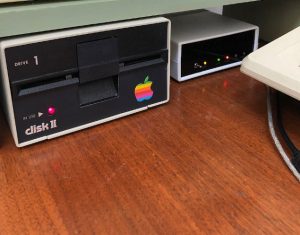
Fun with the Applesauce Floppy Drive Controller
The Applesauce floppy drive controller was invented by John K. Morris. Applesauce combined with the new .woz disk image format for emulators is a major advancement in the archival of Apple II software. I have Apple floppy disks that are 40 years old now, and they are beginning to deteriorate. It’s no fun cleaning iron oxide bits out of your disk drive from a decomposed disk, let me tell you! The Applesauce lets you copy
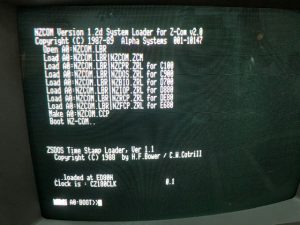
Add NZ-COM, ZSDOS and Clock Card Support to PCPI Applicard (Part 2)
This is a continuation from my previous article that gets CP/M booting on the CFFA 3000 and PCPI Applicard. The goal of this article is to load NZ-COM on top of CP/M, install ZSDOS as a BDOS replacement within NZ-COM, then install clock card support for NZ-COM (clock card support requires ZSDOS). What is NZ-COM? NZ-COM is a powerful overlay for CP/M that replaces CP/M’s Console Command Processor. It provides many benefits that make CP/M
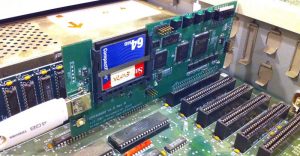
Bootable CP/M System on the CFFA3000 Compact Flash HD for the PCPI Applicard and Apple II (Part 1)
Background: The CFFA 3000 was developed by Richard Dreher and is an absolutely fantastic piece of hardware. It acts as a hard drive for the Apple II and uses either a CompactFlash card or USB flash drive to store the ProDOS partitions. Partitions are easily created using CiderPress or other means and then transferred to the flash card where they boot like a normal ProDOS hard drive partition. But what about CP/M operating systems? Can a CP/M operating system be made

High Speed Imp v2.46
With my collection of CP/M systems growing, I decided to make my high speed version of IMP platform independent. I’ve removed the hardware-specific code from the main program but kept the code changes to support baud rate tables up to 115k. This means you can apply any existing IMP overlay now as long as you sequence your baud steps in this manner: 0=300 1=1200 2=2400, 3=9600, 4=19200, 5=38400, 6=57600, 7=115200 You don’t have to support all of the
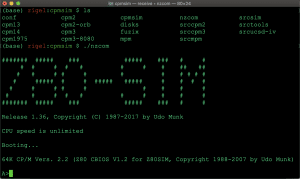
Z80Pack CP/M Emulator and NZ-COM
Z80Pack by Udo Munk is a great CP/M emulator. It will emulate a number of hardware architectures including the Altair and IMSAI systems, but I primarily use it CP/M development environment. I can quickly write or edit CP/M programs and on my MacBook and then transfer them over to my Kaypro or Z-100 for testing. My favorite CP/M 2.2 environment to work in is NZ-COM, also known as Z-System. NZ-COM is sort of like CP/M on steroids.
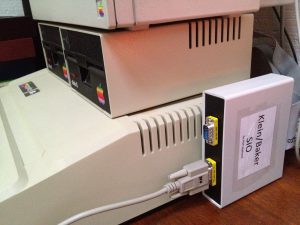
High Speed IMP for the PCPI SIO Card
IMP is a great little terminal program written by Irvin Hoff and I thought it could use a speed upgrade along the same lines as QTerm. The result was IMP_SIO.ZIP. Imp is much simpler than QTerm. It’s one .ASM file and it doesn’t support Kermit, just XModem and YModem. While only one source file, Imp was actually a little bit more difficult to modify because the author originally assumed that no baud rate would ever

High Speed Serial Port Daughter Card for the Apple II PCPI Applicard
The PCPI Applicard is one of the best CP/M cards ever made for the Apple II. It contains a Z80 chip running at either 4 MHz or 6 MHz, has it’s own 64K of RAM, and supports and optional CTC timer chip. It’s one drawback is that I/O is handled through the the Apple II and this severely restricts serial port performance. While I can obtain 115k baud rates in native Apple II mode with
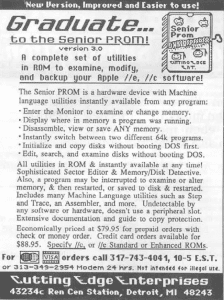
Senior PROM Reverse Engineering for the Apple //e
Background The Senior PROM was a remarkably simple and beautiful debugging/kracking product for the Apple II. Other similar products were the Wildcard and the Crackshot, however, these two products both took up a slot in the Apple II and were also detectable by certain games. Choplifter was one game rumored not to run with a Wildcard installed and it also checked the ROM contents looking for non-factory ROM loads before it launched the game. I
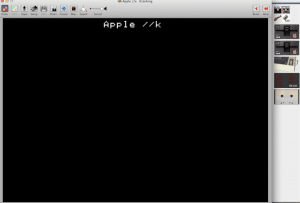
Apple //e ROM Hacking
Background Many years ago I read a great article in Computist Magazine about modifying the Apple ][+ ROM code to allow halting the computer at any point in time for debugging/cracking purposes, something I had always wanted to do as a teenager. The older Apple IIs had monitor ROMs that effectively allowed you to break into the monitor at any point in time, giving you the familiar monitor asterisk prompt. Later Apple II’s that followed,
